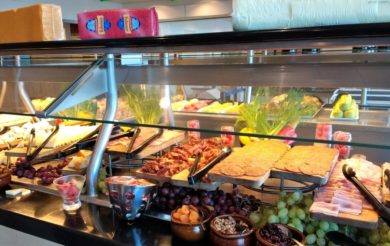Pittsburgh Fine Dining at The Cure
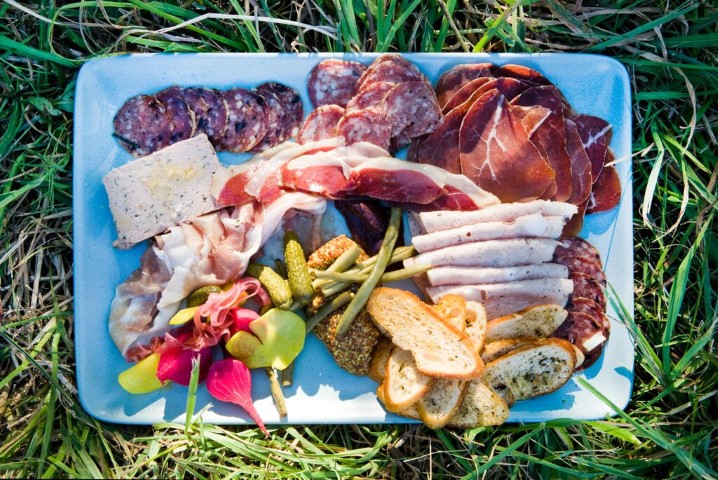
Cure Restaurant in Pittsburgh – Salumi cured meats (photo credit Adam Milliron)
Pittsburgh Fine Dining at The Cure
The Cure a Day Keeps Hunger Away – Pittsburgh’s Fine-Dining Gem
By Muna Salloum
Cure restaurant had been recommended by colleagues in Pittsburgh as one of the best places for dining. That evening as we entered it, we knew that they had a point as the restaurant was a beehive of activity. Every table was occupied and the commotion of voices filled the air. “Aha!” I thought to myself, “My colleagues are right. The place is a magnet for foodies.”
A fascinating name for a trendy upbeat neighbourhood restaurant showcasing the talents of a creative chef whose small menu is focused on what he calls ‘local urban Mediterranean foods’, his dishes are ‘a reflection of the seasons in western Pennsylvania’ revealing the bounty of the area’s local organic farms. When I later asked Chef Justin why the name ‘Cure’, he quickly replied: ’It’s simple. My food cures the hungry.” I was more than willing to see if his words rung true.
As we were led to our tables, that one dilemma that has haunted me in restaurants throughout the years once again faced me: darkness. Albeit there was still a bit of light thanks to what was left of the setting sun, but seated at the table, I had to lean over towards the wicker candle in order to read the menu. A dim-lit dining area for me is a drawback to fine dining. Others find it a plus for romance but seriously not every customer is looking for love when they want to eat good food.
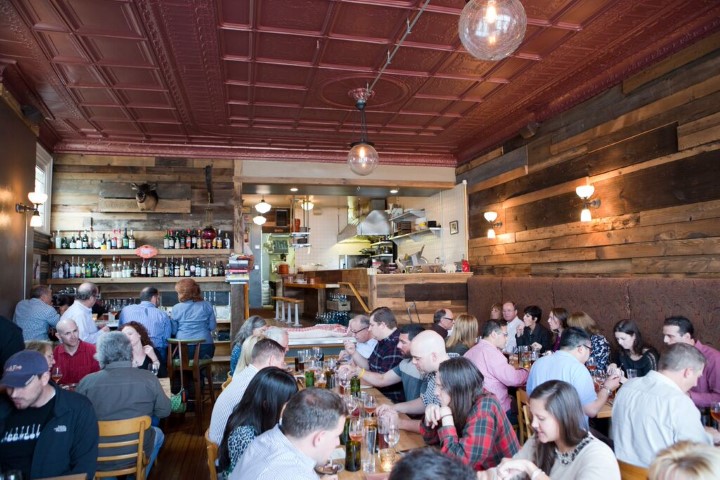
Cure Restaurant in Pittsburgh Interior (photo credit Adam Milliron)
As we sat, I could make out the simplicity of the dining area’s setup – clean, rustic yet elegant. An eclectic décor including a tin ceiling, a wall covered with old barn wood, meat hooks serving as coat hangers, and a large sculpture of a pig hanging from the ceiling, and the open kitchen, add ‘flavour’ to the décor. Cure’s interior design is a reflection of the nuts and bolts of how it creates its specialty menu – cured meats.
I inched my way closer to the candle on the table to read the menu.
From the small selection of appetizers, snacks, pastas, entrees and desserts, it is the Cure’s signature salumi or cured meats that draws the crowds. Despite Chef Justin’s take on the name, the restaurant gets its name from its signature product. For me, this was an absolutely incredible learning experience to know that so many varieties of in-house meticulously cured meats could have so many flavours. Powerfully addictive, I felt that I had to try everything.
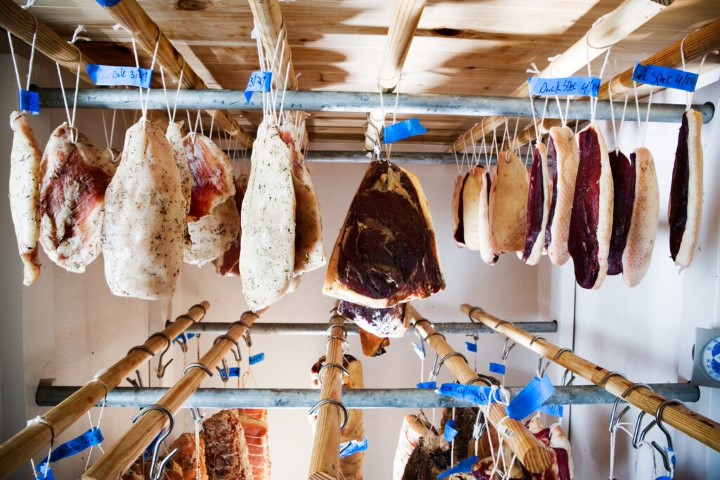
Cure Restaurant in Pittsburgh – in-house cured meats (photo credit Adam Milliron)
The featured appetizer was the salumi de mare that included a choice of either salted dry cod fish, trout, tuna, steelhead roe, calamari, or swordfish. I opted for the wafer-thin shaved tuna served with chili oil and Marcona almonds, a taste sensation as beautiful as its presentation.
When it came to the entrees, chicken, duck, pork, beef and pastas à haute cuisine were the choices all paired with homemade relishes, marinated vegetables, herbs and even fruit. I flip-flopped between choosing the crispy Heritage Farms chicken served with peaches, bacon, pesto and polenta or the Cocoa Tagliatelle pasta teamed with taleggio, Beemster cheese, mushroom sauce, hazelnuts and watercress. My father, sitting next to me, decided on the Meyer Ranch Hanger steak paired with Lyonnais potatoes, tender and spiced alongside porcini aioli, caramelized onion, roasted romaine lettuce leaves, and a fried egg. We ended up sharing the Hanger as we had filled ourselves by nibbling on delicious Rockefeller Oysters topped with spinach, bacon and parmesan. I dipped my slices of the steak into the arugula pesto and the hot fried egg all presented on a large wooden platter. Pure delight, pure pleasure. Of course I kept moving the candle closer to the platter to aim my fork in the right direction. I couldn’t even consider ordering dessert as I had reached the limits of my appetite. But when my colleague began on her decadently Dark Chocolate Soufflé, I didn’t need the candle to find the target. Luscious and light, and complemented with pistachio butter, sea salt, and Vin Cotto, what a way to end a perfect meal.
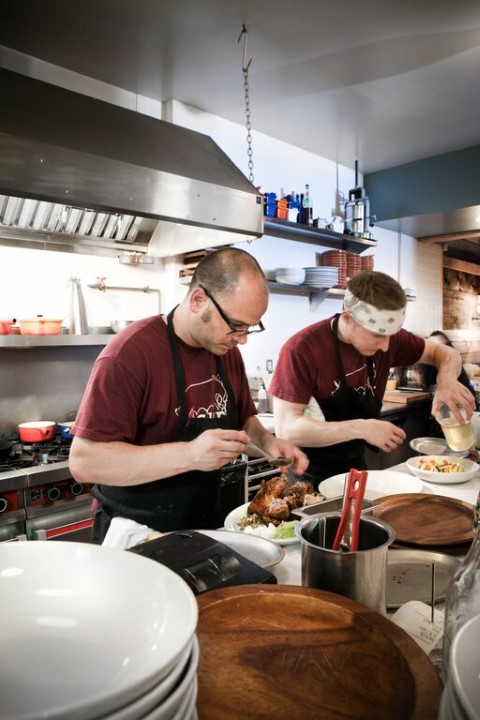
Cure Restaurant in Pittsburgh – Chef Justin Severino (photo credit Adam Milliron)
One of the best moments of the dinner was when Justin Severino, Chef and Co-owner of the Cure, came to our table to welcome us. A man who truly has found his niche, Chef Justin was eager to explain his vision for his restaurant and how it came to be.
After graduating from the Pennsylvania Culinary Institute in Pittsburgh, Chef Justin headed off to Santa Cruz to work at the then newly opened Manresa Restaurant whose theme is the farm-to-table ethic. With his training there he transitioned back to Pittsburgh where opportunities for young people were opening up.
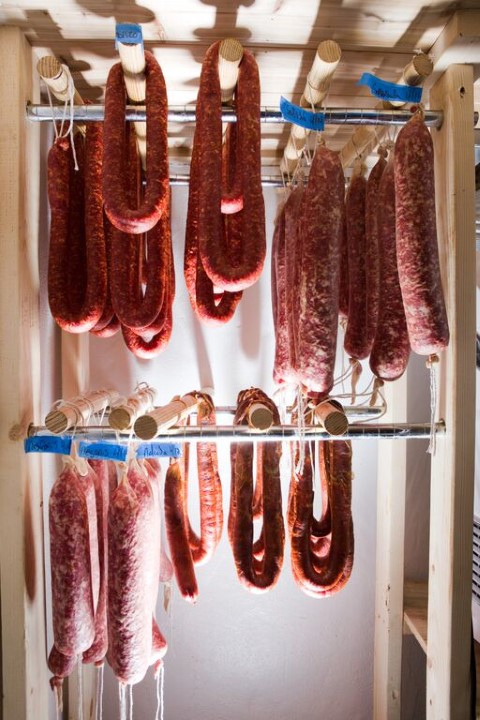
Cure Restaurant in Pittsburgh – in-house cured sausages (photo credit Adam Milliron)
Chef Justin comes from a family of great home cooks. This familial tradition is also part of why his food is so close to the heart. Not just family tradition, as he explained, but also history influences him in developing his epicurean dishes. What he does that is so unique is modern presentations of what is rooted in history. The Cure’s menu, according to Chef Justin, is an expression of himself – constantly changing.
Cure opened in December 2011 and in 2012 Bon Appétit magazine named it as one of the Top 50 Best New Restaurants. Cure is what its name implies – a cure for hunger and for appreciating nature’s bounty in a sophisticated yet rustic manner. This is food at its best, thanks to the talents and determination of a creative chef who believes that history is the determinant to the creative element in cooking.
IF YOU GO:
Cure Restaurant
5336 Butler St., Pittsburgh, PA 15201
Tel: 412-252-2595
BIO:

Muna Salloum
Muna Salloum is a freelance author and writer residing in Toronto, Ontario, Canada. She holds a Master’s Degree in Middle East and Islamic Studies from the University of Toronto, specializing in socio-economic history of the Arabs in Spain. She has had articles concerning stereotyping issues and topical subjects about the Middle East published in various Canadian newspapers, magazines and chapters in books. Currently she writes articles about international and Canadian cuisine and travel. She is co-author of The Sweets of Araby (W.W. Norton, 2011), and co-author of two books: Sheherazade’s Feasts: Medieval Arab Cookery (University of Pennsylvania Press, 2013) and Sweet Delights from a Thousand and One Nights (I.B. Tauris, 2013). Currently she is working on a 15-year research study with Habeeb Salloum on Spanish words of Arabic origin which is near completion, a cookbook on North African and eastern Arab cuisine, and a book on medieval Arab regal foods.





















